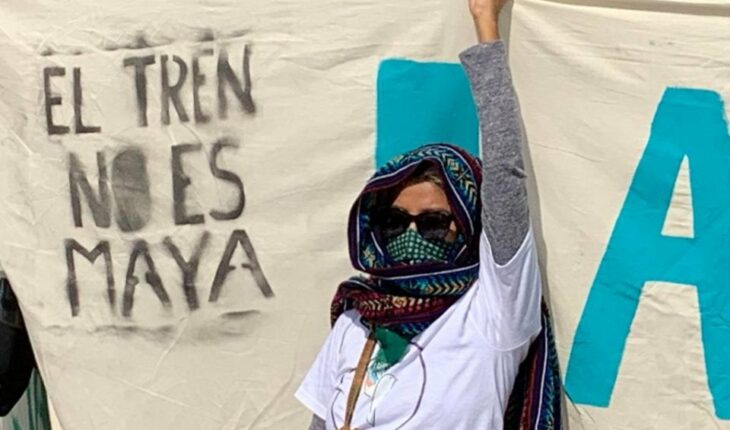National and international environmental defense organizations installed an ‘antimonument’ on Wednesday on the Paseo de la Reforma in Mexico City, to protest the environmental impacts of the Mayan Train in the Yucatan Peninsula.
Around 2:00 p.m., in front of the Torre del Caballito, the activists placed a plaque on the ground that reads: “Here we record that in the name of ‘development’ and ‘progress’ the Mayan Train was built evicting people, extinguishing species, devastating the jungle and threatening ecosystems. Only you, in the future, will be able to say whether it was worth it.”
Roberto Rojo, activist and speleologist of underwater caves in Playa del Carmen, Quintana Roo, one of the points where the Mayan Train will pass, said in an interview that the objective of placing an ‘antimonument’ is to leave “a permanent reminder” before Mexican society of the environmental damage that the work is generating in the ecosystem of the Caribbean jungle. as well as in the underground caves and cenotes.
“Look at the science fiction movies that always start with disaster when you don’t listen to science. Well, here it is the same: from the beginning, we have warned of the fragility of the karst soil of Quintana Roo and the importance of preserving the underground aquifer, the caves and the jungle, “said Rojo, also a biologist.
“Because, if we do not pay attention to these warnings, we are going to have major ecological, human health and ecological disasters,” added the activist, who warned that, due to the fragility of the karst soil through which the train will pass, there is a risk that the project could collapse in the future.
“We don’t want that to happen. What we want is for things to be done correctly, planned and legally, and putting nature first, because without it we are nothing,” he said.
Read more: Budget 2023: social programs, the works of the Mayan Train and the Armed Forces, the favorites of the cast
Civil organizations placed a plaque denouncing the ecological impacts that the #TrenMaya is causing in the Yucatan Peninsula.
🗣️ Roberto Rojo, underwater cave speleologist in Playa del Carmen, Quintana Roo, and activist of the @SelvameMX movement.
📹 : @ManuVPC. pic.twitter.com/WytIEC7sjA
— Political Animal (@Pajaropolitico) November 23, 2022
Other organizations that participated in the protest were Racismo Mx, Cenotes Urbanos, Kanan Derechos Humanos or SumOfUs, which denounced that the Mayan Train project was “imposed in a totally irregular manner,” mentioning that the consultations with indigenous peoples made by the federal government in 2019 “did not comply with international standards.”
“This is not a ‘Mayan’ train, it is a colonial train that promises development and progress, but without the free and informed consent of the affected communities,” said one of the SumOfUs activists, who denounced the participation of “colonial” European companies in the project to benefit economically “at the expense of human rights violations.”
“We wonder if these European companies would do the same in their countries,” the environmentalist questioned.
Rojo recalled that, so far, an “integral” Environmental Impact Statement has not been announced, but that it has been “fragmented” into several sections of the work, “so as not to publicize the true impact of the Mayan Train.”
“This is an ecocidal train disguised as tourism and progress,” criticized the also member of the Mayab Speleological Circle.
On September 4, President Andrés Manuel López Obrador announced that, after several months detained for amparos before the courts, the work of the Mayan Train was restarted.
“With absolute adherence to legality, patience and the support of the people, we restart the work of the Cancun-Tulum section. The legal, environmental or social protections did not proceed. There will be Mayan Train,” he tweeted.
Earlier, on August 9, a federal judge denied the last definitive suspension against the construction of Section 5 of the Mayan Train, which runs from Playa del Carmen to Tulum, Quintana Roo. With that resolution, six denied suspensions were joined.
Activists and experts from the #SélvameDelTren collective had asked the president to tour with them the area where Section 5 is being built, which crosses jungles, caves and cenotes, to change the layout of the work and avoid a natural disaster, but that did not happen.
On August 1, a decree came into force expropriating an area of 1,093,118 square meters of private property for the construction of Section 5.
What we do at Animal Político requires professional journalists, teamwork, dialogue with readers and something very important: independence. You can help us to followr. Be part of the team.
Subscribe to Animal Político, receive benefits and support free journalism#YoSoyAnimal




